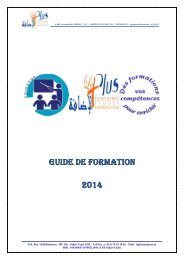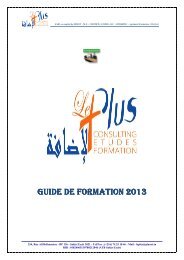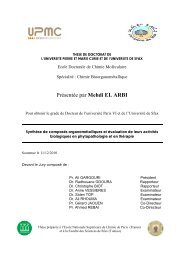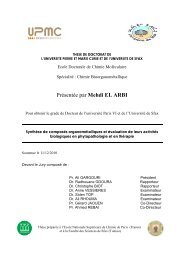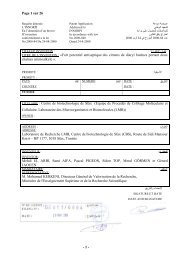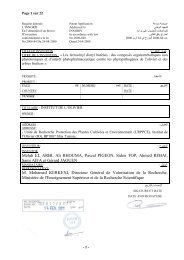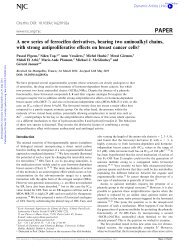ANTIMICROBIAL EFFECT OF FERROCENYL DIARYL BUTENES AGAINST OLIVE PLANTLET DISEASES
These compounds efficiently inhibited the growth of these microorganisms in culture media and in inoculated plantlets which did not contract the corresponding diseases, especially when treated with P8. These findings shed light on the potential utilisatio
These compounds efficiently inhibited the growth of these microorganisms in culture media and in inoculated plantlets which did not contract the corresponding diseases, especially when treated with P8. These findings shed light on the potential utilisatio
You also want an ePaper? Increase the reach of your titles
YUMPU automatically turns print PDFs into web optimized ePapers that Google loves.
Journal of Plant Pathology (2011), 93 (3), 651-657 El Arbi et al. 653<br />
droxyphenyl)-2-ferrocenyl-but-1-ene citrate (P7) (El Arbi<br />
et al., 2011) and 1,1-bis[4-(3-dimethylamoniumpropoxy)<br />
phenyl]-2-ferrocenyl-but-1-ene citrate (P8) (El Arbi et al.,<br />
2011) were synthesized as described in the above references<br />
and reported for their antiproliferative activity on<br />
breast cancer cells.<br />
Materials for biological assays. Plantlets of cv. Chemlali<br />
were produced from in vitro-grown explants at the Institut<br />
de l’Olivier de Sfax using standard procedures<br />
(Rugini, 1984). P. savastanoi pv. savastanoi (CFBP 5514)<br />
was a gift of Dr. M.M. López (Instituto Valenciano de<br />
Investigaciones Agrarias, Valencia, Spain), A. tumefaciens<br />
(CFBP 1903) was obtained from Dr. X. Nesme<br />
(Université Lyon 1, France), whereas F. solani was isolated<br />
at the Institut de l’Olivier de Sfax.<br />
Plate count agar tests. The antimicrobial effect of ferrocene<br />
compounds, used at a dose of 1 mg ml –1 , was assessed<br />
using the well method (Tagg and Mc Given, 1971).<br />
The different pathogens (Fig. 2) were plated on plate<br />
count agar (PCA) medium (5 g l –1 peptone, 2.5 g l –1 yeast<br />
extract, 1 g l –1 glucose and 15 g l –1 agar) and the effect<br />
was evaluated measuring the size of inhibition zones.<br />
Fig. 2. Antimicrobial effect of P4 and P5 (1 mg ml –1 ) against<br />
Agrobacterium tumefaciens (CFBP 1903).<br />
Determination of the minimal inhibitory and minimal<br />
bactericide concentrations. Antimicrobial activity<br />
was determined by the tube dilution method. Twofold<br />
dilutions of each compound under trial were prepared<br />
in PCA liquid medium. A suspension of the standard<br />
microorganisms, prepared from 24 h cultures of bacteria<br />
in PCA liquid medium at a concentration of 10 6<br />
CFU ml –1 , was added to each dilution in a 1:1 ratio.<br />
The same procedure was followed for fungi by using a<br />
spore suspension. Growth (or lack thereof) of the microorganisms<br />
was determined visually after incubation<br />
for 24 h at 37°C. The lowest concentration at which<br />
there was no visible growth was taken as the minimal<br />
inhibitory concentration (MIC). Then, one loopful<br />
from each tube was cultured on PCA and incubated<br />
for 24 h at 37°C. The lowest concentration of the compound<br />
that showed no colony formation was defined as<br />
the minimal bactericide concenration (MBC). Doxycycline<br />
and CuSO 4 were used as standards. Solutions of<br />
the test compounds and Doxycycline were prepared in<br />
ethanol at a concentration of 2 mg ml –1 . The twofold<br />
dilutions of the compounds were prepared (200, 100,<br />
50, 25, 12.5 µg ml –1 ). Microorganism suspensions at<br />
10 6 CFU ml –1 were inoculated into the corresponding<br />
test tube.<br />
Phytotoxicity test. The method of Zucconi et al. (1981)<br />
was used, determining the germination index of tomato<br />
seeds according to the following formula:<br />
IG = Number of germinated seeds in the assay ×<br />
Number of germinated seeds in the control<br />
Average of root length in the assay × 100<br />
Average of root length in the control<br />
In vivo antimicrobial tests. One-year-old and 4-monthold<br />
plantlets of cv. Chemlali from in vitro culture were<br />
wounded and infected with 10 µl of 10 8 CFU ml –1 inocula<br />
of P. savastanoi pv. savastanoi and A. tumefaciens, respectively.<br />
Three days after inoculation, the wounds were<br />
treated with a P8 solution. Inoculation with F. solani was<br />
performed by spraying the wounds (in leaves and stems) with<br />
a suspension of 10 6 spores ml –1 and treated by spraying with<br />
P8 solution after 1 h. A. tumefaciens-inoculated plantlets<br />
were maintained in a growth chamber at 25±1°C, under<br />
cool white fluorescent lamps (45 µmol m -2 s -1 ) with a<br />
16 h photoperiod, whereas plantlets inoculated with P.<br />
savastanoi pv. savatanoi and F. solani were maintained in<br />
glasshouse at room temperature.<br />
RESULTS AND DISCUSSION<br />
Bioassays. When tested on PCA, products P4 and<br />
P5 inhibited the growth of the three microorganisms<br />
under trial. Compared to controls the highest inhibition<br />
was given by 1-bis[4-(3-dimethylaminopropoxy)phenyl]<br />
-2-ferrocenyl-but-1-ene (P5) (Fig. 2). The conversion to<br />
citric acid salts of products P4 and P5 allowed the total<br />
hydrosolubility of bis[4-(3-dimethylamoniumpropoxy)<br />
phenyl]-2-ferrocenyl-but-1-ene citrate (P8) and the partial<br />
hydrosolubility of 1-[4-(3-dimethylamoniumpropoxy)<br />
phenyl]-1-(4-hydroxyphenyl)-2-ferrocenyl-but-1-ene<br />
citrate (P7).




